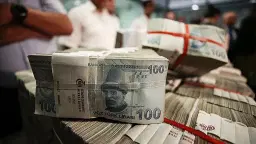Second quarter’s growth rate is substantially below the potential rate of 4.5-5 percent.
During July, I speculated on growth rate of the second half of the year. Here is a section from the commentary dated July 17: “it appears that second quarter growth was not much different than the first concerning growth performance and that it might outperform the first only slightly.” And this one is from July 10: “In other words, the second quarter is hardly different from the first. All we can expect is a slightly higher growth rate; not relatively or evidently.”
And the growth rate for the second quarter was finally announced: the Turkish economy grew year-on-year by 2.9 percent, against the 3.3 percent in the first quarter (the rate was revised upwards by 0.1 points). In the first half of the year, therefore, growth rate stood at 3.1 percent, with growth in second quarter slightly below the first quarter. The figures validated my estimation that “the second quarter will not much different from the first concerning growth performance.” On the other hand, I was expecting that the difference, if any, would be in favor of the second quarter. This estimation of mine proved wrong as second quarter growth rate was slightly lower than the first quarter.
I would like to stress some points that strike attention. First, 3.1 percent growth recorded in the first half of the year is substantially below the potential rate of 4.5-5 percent. Second, private investment expenditures showed a downturn in the second quarter, with a severe year-on-year drop by 7.9 percent. For the first half overall, private investment expenditures decreased year-on-year by 3.5 percent. Yet, this is not surprising as polls and surveys with businesspeople have been signaling that confidence in the economy has been eroding. Third, in the second quarter, private sector consumption expenditures also decreased. The only factor that prevented contraction was the strong growth in exports beyond imports. Net foreign demand therefore made a large contribution to growth, with 5.7 points.
Also, there are signals that the growth rate in the third quarter will not be much different from that in the first half of 2012. Non-gold export figures released by the TURKSTAT showed limited improvement in July. Data by the Turkish Exporters’ Assembly suggests that non-gold exports decreased year-on-year in August. Since the late 2011, non-energy and non-export imports have been weakening year-on-year. The TURKSTAT estimates a year-on-year drop in cereal production and a rise in vegetable and fruit production. Value added in the agricultural sector is generated mainly in third quarters. As far as I know, grain that has the major share of agricultural value added is cultivated during the last month of second quarter and the first month of third quarter. In the light of these, we can assume that agricultural sector will contribute negatively to third quarter growth (not necessarily a contraction but weaker performance compared to other sectors). Meanwhile, real sector confidence index is in decline. As I also stated above, the fall in private sector investment expenditures is closely tied to this trend.
There also is good news concerning the third quarter: first, in the April-August period, lira denominated loans (annualized weekly changes derived upon the average figures for thirteen weeks) increased compared to the previous six-month period. Second, since the late July, the average cost of Central Bank lending to banks (the actual policy rate) has shown a steep drop. And here is a neutral indicator: industrial output growth was higher in July than in April and June but lower than May. I will elaborate on each later.
This commentary was published in Radikal daily on 11.09.2012





